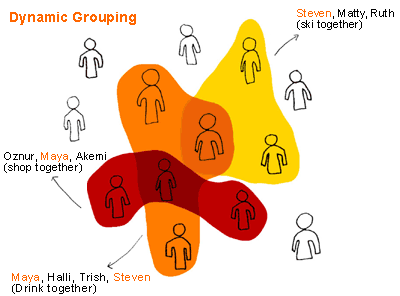 |
 |
FACULTY:
Neil Churcher, Michael Kieslinger, Molly wright Steenson, Jan Christoph Zoels
Team:
Steven Blythe, Ruth kikin-Gil, Maya Lotan
|
 |
|
 |
Room Mates : Exploration and learnings
|
|
 |
Concepts we wanted to explore:
: : What is a (social) Group?
: : What is an Event?
: : What is the relationship between them?
: : What is the motivation for exposing personal information?
We looked for the answers in different places:
: : Web based social software
: : Mobile devices
: : Current mobile services
: : Self exploration of social networks and behaviors
: : Readings
Our learnings :
People use mobile devices as an integral part of their social lives; they use them to communicate, to schedule business and social events, to send "attention signals" and more.
: : Groups
People tend to gather in groups that reflect mutual activities and interests
These groups are flexible and vague structures that modify according to change in interests of their members
The nature and density of communication within these dynamic groups, change accordingly
However vague they are, their participants know exactly who takes part in which group. They just don't really talk about it.

: : Motivation for exposing personal information
People like to share and recall moments and experiences thus increasing their sense of belonging.
: : Events
An event (I.E.: a date, going shopping together, a concert, a meeting in a cafe) is not confined to the physical time and space, but is rather a complex, fuzzy experiences that has a specific realization point with a collection of fuzziness around it . A great deal of communication is happening among the participants before, during and after the event; from the moment someone came up with the idea, through the scheduling, inviting and coordinating stages and until the moments of comparing and experiences long after it ended.

|
 |
 |
Definitions for framework building Blocks
The 3 main building blocks in the system are the PEOPLE (the names in my address book)
The Events, which we call "ITEMS"
And the groups, which are represented in the "ROOMS"
Our next step was to create the INTERACTION CONCEPT
|
|
|
